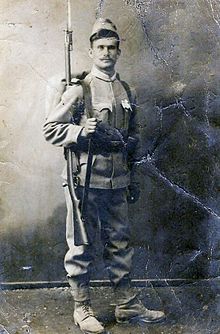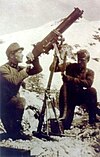Mannlicher M1888
This article has multiple issues. Please help improve it or discuss these issues on the talk page. (Learn how and when to remove these messages)
|
| Repeating Rifle Muster 1888 | |
|---|---|
 Mannlicher M1888 rifle, from the collections of the Swedish Army Museum. | |
| Type | Bolt-action rifle |
| Place of origin | Austria-Hungary |
| Service history | |
| In service | 1888–1945 |
| Used by | See Users |
| Wars | Philippine Revolution, 1891 Chilean Civil War, Boxer Rebellion, First Balkan War, Second Balkan War, Russian Civil War,[1] Revolutions and interventions in Hungary, Polish–Soviet War,[2] Greco-Turkish War,[3] Spanish Civil War, Sudeten German uprising 1938, World War I, World War II (Volkssturm) |
| Production history | |
| Designer | Ferdinand von Mannlicher |
| Designed | 1887–1888 |
| Manufacturer | Steyr-Mannlicher, Fegyver És Gépgyár |
| Produced | 1888–1896 |
| No. built | 1,095,000 |
| Variants | M1888-90, M1888-95, M1888/24[4] |
| Specifications (M88) | |
| Mass | 4.41 kg (9.7 lb) |
| Length | 1,280 mm (50 in) |
| Barrel length | 765 mm (30.1 in) |
| Cartridge | M88 8×52mmR M88-90 and M88-95: 8×50mmR M88/24: 8×57mm IS |
| Action | Straight-pull bolt action |
| Muzzle velocity | 530 metres per second (1,700 ft/s) with M1888 ball cartridge |
| Feed system | 5-round en-bloc clip (stripper clip in M88/24), integral box magazine |
| Sights | Iron sights |
The Repeating Rifle Muster 1888 better known as Mannlicher M1888 was a bolt-action rifle used by several armies from 1888 to 1945. Derived from the M1885 and later M1886 models, it was Ferdinand Mannlicher's third rifle that utilized the "enbloc clip".
It was succeeded by the Mannlicher M1895 as the standard service rifle of the Austro-Hungarian Army. The M95 uses a more secure rotating-bolt, in contrast to the M88's wedge-lock bolt.
History

The M1888 was a direct and immediate descendant of the M1886 Austrian Mannlicher. This rifle too was a straight-pull, bolt-action, box magazine repeater. As early as the beginning of production of the M1886 the need and desirability for a small-bore rifle was evident. This rifle is virtually identical to its predecessor but for chambering a newly designed 8 mm cartridge, loaded originally with black powder and denominated 8×52mmR.

M1888-90 rifle
Shortly thereafter, the M88 cartridge was converted to semi-smokeless powder. The new cartridge was designated 8mm M.1890 scharfe Patrone and its dimensions were 8×50mmR. The sights of existing black powder 8mm Mannlicher rifles were converted to accommodate semi-smokeless ammunition by the functional arrangement of screw mounting re-graduated sideplates onto the outsides of the existing rear sight walls. The converted rifles were denominated M.88–90.
M1890 rifle
When in 1890 semi-smokeless powder became available, manufacture of rifles with a longer and thus stronger chamber and modified sights began. Although the smokeless powder filled M.93 8×50mmR cartridge can be used in this rifle, the generated pressure at 40,000 psi (275.8 MPa) is marginal, as the wedge-lock bolt system this rifle uses was originally designed to be shot with less potent black powder filled 11×58mmR ammunution.
Users
 Austria-Hungary
Austria-Hungary First Austrian Republic
First Austrian Republic Ecuador[5]
Ecuador[5] Kingdom of Bulgaria
Kingdom of Bulgaria China[6]
China[6] Czechoslovakia
Czechoslovakia Sudeten German Party
Sudeten German Party Spain
Spain Nazi Germany: Used by Volkssturm.
Nazi Germany: Used by Volkssturm. Kingdom of Greece: Captured from Bulgaria during the Second Balkan War and at the end of World War I.[3]
Kingdom of Greece: Captured from Bulgaria during the Second Balkan War and at the end of World War I.[3] Kingdom of Hungary
Kingdom of Hungary Kingdom of Italy
Kingdom of Italy Persia
Persia Philippines
Philippines Second Polish Republic
Second Polish Republic Thailand: According to Steyr sales records, 15,000 M1888 rifles were furnished to Siam, most in the 1890s. Some may have been used items, sold from Austrian military stocks.[7]
Thailand: According to Steyr sales records, 15,000 M1888 rifles were furnished to Siam, most in the 1890s. Some may have been used items, sold from Austrian military stocks.[7] Chile[8]
Chile[8]
References
- ^ http://www.fhhljx.com/thefreelibrary/Russian+rifles+of+the+great+war,+revolution+%26+civil+war--part+I%3A...-a0391733875
- ^ http://ossow1920.pl/index.php/aktualnosci/biezace-wydarzenia/99-bron-strzelecka-wojska-polskiego-w-wojnie-polsko-bolszewickiej
- ^ a b http://gunsmagazine.com/weapons-of-the-greco-turkish-war/
- ^ http://gunbg.com/index.php?topic=6494.0
- ^ Robert W.D. Ball (2 August 2011). Mauser Military Rifles of the World. Gun Digest Books. p. 127. ISBN 1-4402-1544-8.
- ^ Philip S. Jowett (2010). Chinese Warlord Armies, 1911–30. Osprey Publishing. pp. 43–. ISBN 978-1-84908-402-4.
- ^ http://worldbayonets.com/Bayonet_Identification_Guide/Siam__Thailand_/siam_2.html
- ^ John Walter (25 March 2006). Rifles of the World. Krause Publications. pp. 263–271. ISBN 0-89689-241-7. Retrieved 8 September 2014.
- "8 x 50 R Mannlicher - www.militaryrifles.com/Austria/88Mann.htm". militaryrifles.com. Retrieved 22 November 2013.

